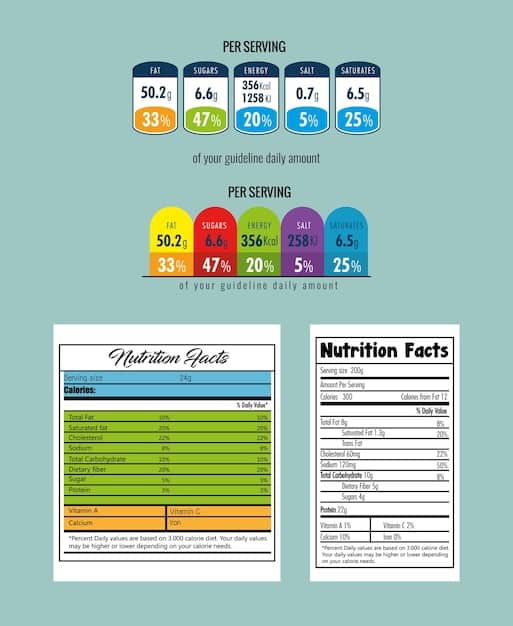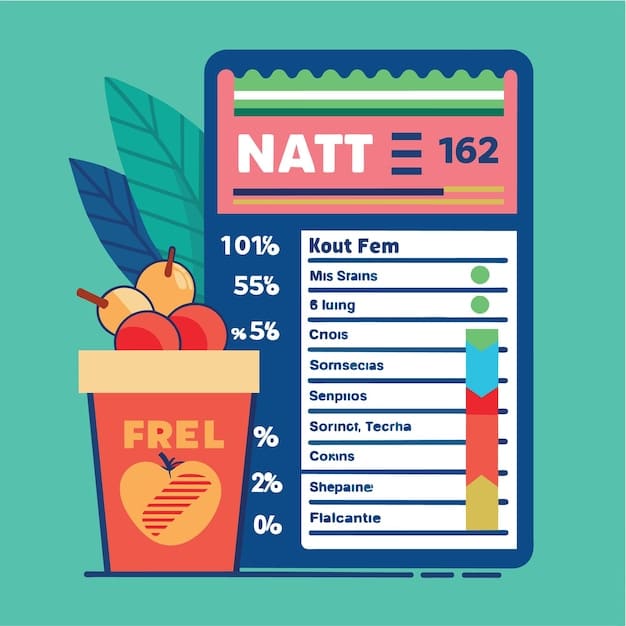Decoding Food Labels: The Ultimate Guide to Healthier Choices

The Ultimate Guide to Understanding Food Labels and Making Healthier Choices provides a comprehensive resource for navigating nutritional information, empowering consumers to make informed dietary decisions and improve their overall health.
Navigating the grocery store can feel like decoding a secret language, especially when it comes to food labels. This The Ultimate Guide to Understanding Food Labels and Making Healthier Choices is designed to empower you with the knowledge needed to decipher these labels, enabling you to make informed decisions that support your health goals.
Understanding the Basics of Food Labels
Food labels are your first point of contact when assessing the nutritional value of a packaged food. Understanding the different components and knowing where to find key information is essential. Let’s break down the fundamental elements you’ll encounter on every label.
The Nutrition Facts Panel
The Nutrition Facts panel is a standardized format providing detailed nutritional information. This panel is generally located on the back or side of the packaging and it’s your primary tool for quickly gauging the food’s nutritional profile.
Serving Size
Always pay attention to the serving size listed at the top of the panel, as all the nutritional information that follows is based on this amount. Consider whether the serving size listed is realistic for your typical consumption.
- Check the serving size first: Is it a reasonable portion for you?
- Compare your portion to the serving size: Adjust nutritional information accordingly.
- Be aware of multiple servings per container: Calories and nutrient values multiply.
Understanding these basic elements will set the stage for deeper analysis. Using this knowledge helps you compare different items more effectively.
Decoding the Nutrition Facts Panel
Once you understand the basics, you will need to know what the nutrition facts actually mean to you. It all boils down to understanding what the numbers quoted in the label refer to.

Calories: Energy In
Calories represent the energy you get from consuming the food. Keeping track of calories is important for weight management and overall energy balance. Keep an eye on the source of the caloric value and how it will impact your daily nutrition values.
Fats: Not All Are Created Equal
Fats are an essential part of a healthy diet, but it’s important to differentiate between healthy and unhealthy fats. You’ll find information on total fat, saturated fat, trans fat, and sometimes polyunsaturated and monounsaturated fats.
- Saturated Fats: Limit intake, as they can raise cholesterol levels.
- Trans Fats: Avoid completely, as they offer no health benefits and increase heart disease risk.
- Unsaturated Fats: Choose these, as they support heart health.
Understanding the types of fats and making informed decisions is crucial for cardiovascular health. Pay attention to the fat content as it relates to your overall dietary goals.
Focusing on Key Nutrients: What to Look For
Focusing on key nutrients such as carbohydrates, fiber, sugars, protein, vitamins, and minerals will assist greatly in understanding what you are consuming. This will allow you to have a well rounded diet that is optimal for your body.
Carbohydrates, Fiber, and Sugars
Carbohydrates are your body’s primary energy source. The Nutrition Facts panel breaks down carbohydrates into fiber, total sugars, and added sugars. Fiber is beneficial for digestive health and helps you feel full, while added sugars should be limited.
- Fiber: Aim for high fiber content, as it promotes satiety and digestive health.
- Total Sugars: Be mindful of the total sugar content, including natural and added sugars.
- Added Sugars: Limit intake, as they contribute to empty calories and potential health issues.
Protein: The Building Block
Protein is essential for building and repairing tissues, as well as supporting various bodily functions. Check the protein content to ensure you’re meeting your daily needs, especially if you have specific dietary requirements or fitness goals.
Vitamins and Minerals: Micronutrient Must-Haves
Vitamins and minerals are crucial for overall health, supporting everything from immune function to bone strength. The Nutrition Facts panel lists key vitamins and minerals, often expressed as a percentage of your daily value. Knowing how to interpret vitamin and mineral percentages is very important.
Understanding Percentage Daily Values (%DV)
The %DV (% Daily Value) on a food label helps you see how much of a nutrient is in a single serving of the food, in terms of the daily requirement. It can help you determine if a food is high or low in a specific nutrient.
What %DV Means
Percentage Daily Value (%DV) is a reference point indicating how much of a nutrient a serving of food contributes to your total daily diet. Generally, 5% DV or less is considered low, while 20% DV or more is considered high.

Interpreting %DV
Use %DV as a guide to make balanced food choices. If a nutrient is high, it contributes a significant amount to your daily needs, while a low value suggests you may need more of that nutrient from other sources.
Understanding and effectively using the %DV can greatly simplify your food selection process. Being able to properly interpret these measures enables individuals to make informed and confident choices.
Navigating Common Label Claims
Food labels often include claims designed to catch your attention, highlighting potential health benefits or specific attributes of the product. However, these claims can sometimes be misleading or confusing. It’s important to understand what these terms actually mean and how to interpret them accurately.
“Low Fat,” “Reduced Sodium,” and Other Descriptors
Terms like “low fat,” “reduced sodium,” and “sugar-free” have specific definitions set by regulatory bodies like the FDA. Understanding these definitions can help you make more informed comparisons between products. Make sure to read up on these terms so you can accurately interpret the nutritional value of these products.
Organic and Non-GMO Labels
Organic and Non-GMO labels indicate that the product meets certain standards related to farming practices and genetic engineering. While these labels can provide valuable information, it’s important to understand what they do and do not guarantee.
Ultimately, critical assessment of food label claims will guide you toward genuine nutrition. Do some research on what terms are regulated and have your nutrition and health goals in mind as you shop.
Putting It All Together: Making Healthier Choices
Armed with a solid understanding of food labels, you’re now ready to put that knowledge into action. This involves not only reading the labels but also using the information to strategically choose foods that align with your health goals.
Comparing Products
One of the most effective ways to use food labels is to compare similar products side by side. Focus on serving sizes, calorie counts, and key nutrients to identify the healthier option. Reading the nutrition contents of different products and understanding them aids you in making healthier decisions.
Planning Your Meals
Use food labels to plan your meals and snacks in advance, ensuring a balanced intake of nutrients throughout the day. Consider incorporating a variety of nutrient-dense foods while limiting those high in added sugars, saturated fats, and sodium.
- Plan balanced meals with adequate protein, fiber, and healthy fats.
- Limit processed foods high in added sugars, sodium, and unhealthy fats.
- Incorporate a variety of nutrient-dense foods to meet your micronutrient needs.
Understanding food labels empowers you to make informed decisions that directly impact your health. With a bit of practice, you’ll find it easier to navigate the grocery store and choose foods that support your well-being.
| Key Point | Brief Description |
|---|---|
| 🧐 Serving Size | Nutritional info is based on this amount; adjust accordingly. |
| 💪 Protein Intake | Ensure adequate protein to help with tissue repair. |
| 🥗 Fiber Content | Prioritize high fiber to help with digestive health. |
| 🍬 Added Sugars | Limit added sugars, which contribute to empty calories. |
Frequently Asked Questions (FAQ)
▼
Total sugars include all sugars in the product, both naturally occurring and added. Added sugars are those introduced during processing. It’s best to minimize added sugars for optimal health.
▼
Generally, a %DV of 5% or less indicates the food is low in that nutrient, while a %DV of 20% or more indicates it is high in that nutrient.
▼
Not necessarily. “Organic” refers to farming practices. While organic foods avoid synthetic pesticides, they can still be high in sugar, fat, or calories. Always check the Nutrition Facts panel.
▼
“Reduced sodium” means the product has at least 25% less sodium than the regular version. It’s helpful, but always compare the actual sodium content to your daily needs.
▼
The ingredients are always listed in descending order by weight. The first few ingredients make up the majority of the product, so prioritize foods where those ingredients are whole and nutritious.
Conclusion
By understanding and applying the knowledge outlined in this guide, you can empower yourself to make informed food choices that support your health and wellness goals. The journey to a healthier lifestyle begins with a single label.





